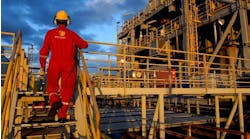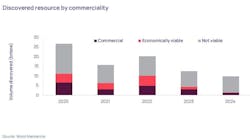By Jeremy Beckman, London
NORTH AMERICA
Shell Offshore has taken FID on a waterflood project at the ultra-deepwater Vito field in the Mississipi canyon area. Oil production started in February 2023, with the three water injector wells already drilled as pre-producers. Shell aims to start injection into the reservoir in 2027 to displace more oil, with the goal of recovering a further 60 MMboe.
***
BP has chosen Exmar Offshore to design the hull of the floating production unit for the newly launched Kaskida development in 6,000 ft water depth in the Keathley Canyon area, 250 mi (402 km) south-west of New Orleans. The platform will be engineered to produce 80,000 b/d of oil from six wells in an initial phase, recovering around 275 MMboe. Exmar will base the hull on its patented OPTI design; Audubon Engineering will perform engineering of the topsides engineering, drawing on its experience with the Delta House, Kings’s Quay and Shenandoah semisubmersible platforms. BP expects first oil in 2029.
In the Green Canyon area, 225 km (140 mi) offshore Louisiana, Chevron has started production from the Anchor development. The subsea wells, tied back to a semisubmersible FPU, will deliver up to 75,000 b/d of oil and 28 MMcf/d of gas. The platform features all-electric motors and controls to minimize emissions and heat/steam recovery modules.
***
Woodside Energy has expanded SBM Offshore’s work scope for the deepwater Trion oil project offshore Mexico to construction of the 950,000-bbl Floating Storage and Offloading (FSO) unit, followed by a 20-year lease of the vessel. Last year Woodside awarded the company the T&I contract for the FSO and the FPU.
CARIBBEAN SEA/SOUTH AMERICA
McDermott has an EPCI assignment from Shell for the Manatee offshore gas development, 60 mi (100 km) from the south-east coast of Trinidad and Tobago. Its responsibilities cover the platform and jacket, the 32-in. pipeline taking production from the facility to a Shell gas processing plant, and a subsea fiber optic cable.
BP Trinidad and Tobago has agreed to transfer to Perenco its 100% ownership of four offshore gasfields commissioned between 1993 and 2007 – Amherstia, Cashima, Flamboyant and Immortelle – and the undeveloped 1968 discovery Parang. Current production (Flamboyant is offline) totals around 30,000 boe/d: bpTT expects to close the transaction by the end of this year and will continue to purchase all gas volumes to meet its contractual obligations.
***
Petrobras has signed 29 concession contracts – all but three in partnership with Shell – over blocks in the deepwater Pelotas basin offshore south-east Brazil. All were made available late last year under the country’s 14th Permanent Concession Offer.
WEST AFRICA
Liberia’s Petroleum Regulatory Authority has launched a direct negotiation licensing round covering 29 offshore blocks in the Harper and Liberia basins. TGS is supporting the process by offering to interested parties 24,000 km (14,913 mi) of 2D and over 26,000 sq km (10,039 sq mi) of 3D seismic data from its multi-client library, some of which has been newly reprocessed. Geological plays range from the syn-rift Lower Cretaceous to the deepwater Upper Cretaceous.
***
TotalEnergies and QatarEnergy International have followed partner CNR international by announcing their withdrawal from deepwater Block 11B/12B offshore the southern coast of South Africa. Despite making two large and apparently commercial gas-condensate discoveries on the Brulpadda and Luiperd prospects, TotalEnergies claimed that finding an economic development solution for the South African market was “too challenging.”
NORTH-WEST EUROPE
Viaro Energy subsidiary RockRose Energy has struck a deal to buy multiple producing gas fields in the southern UK North Sea owned jointly by Shell and ExxonMobil, and all operated by Shell. Assuming regulatory approval, Viaro will acquire the Barque, Brigantine, Caravel, Carrack East, Carrack Main, Clipper, Corvette, Galleon, Leman, Shamrock and Skiff fields which produced around 28,000 boed/d last year. Viaro sees potential to develop over 120 MMboe of net 2C resources.
***
OMV Norge has discovered gas-condensate in the Norwegian Sea via a multi-target well on the Haydn/Monn prospects, in 1,064 m (3,491 ft) water depth. The company assesses recoverable reserves at 30-140 MMboe and is eyeing a subsea tieback to Equinor’s Aasta Hansteen spar platform, which exports gas to Norway’s west coast through the Polarled pipeline.
***
Vår Energi and its partners are working on two further more phases for their Balder Area redevelopment in the North Sea, which is designed to extend production beyond 2045. Drilling of the six production wells for Balder Phase V will start next year from remaining subsea well slots. Phase VI would add new subsea facilities and more wells, with an investment decision planned for the first half of 2025.
MEDITERRANEAN SEA
Eni has delivered first gas from the Argo Cassiopea field in the Strait of Sicily. Within a few months, all four subsea production wells should be connected to the new 60-km (37.3 mi) subsea pipeline to the onshore processing complex at Gela. From there the gas will feed through to Italy’s national grid.
***
Chevron has submitted an updated development and production plan to the Cypriot authorities for the Aphrodite gasfield in block 12 offshore Cyprus, 160 km (99.4 mi) south of Limassol. The proposal calls for an initial four subsea wells that will be tied back to a floating production system that will be installed over the field in 1,700 m (5,577 ft) water depth, and designed to produce around 800 MMcf/d. Production would then head through a subsea pipeline to the Egyptian transmission system.
***
Energean has taken FID on the multi-field Katlan gas development in up to 1,800 m (5,905 ft) of water offshore Israel. Phase 1, covering the Apollo, Athena, Hera and Zeus accumulations (229 MMboe in total) will be a four-well subsea tieback to a 30-km (19.9-mi) production pipeline connected to the Energean Power FPSO at the Karish field. It will also be the first project to feature TechnipFMC’s new Subsea 2.0 production systems. Energean is aiming for start-up in the first half of 2027.
MIDDLE EAST
Saipem has secured two new EPCI contracts with a combined value of $1 billion for projects offshore Saudi Arabia under its Long-Term Agreement with Saudi Aramco. One contract covers three new production deck modules, subsea rigid pipelines and power cables for the Marjan oil and gas field. The other, for the Safaniyah and Zuluf fields, is for three jackets, five production deck modules and 62 km (32.3 mi) of subsea rigid and flexible pipelines and power cables. Construction will take place in Dammam at Saipem Taqa Al-Rushaid Fabricators.
ASIA-PACIFIC
Offshore Sarawak, Petronas has started production from the 10-tcf Kawasari field development in Block SK316, at an initial rate of 200MMcf/d. The 53,893-metric ton (53,042-ton) central processing platform is the heaviest to date for an installation offshore Malaysia, and is bridge-linked to a flare platform and a wellhead facility. Production is sent to a new riser platform at the offshore E11 hub and onward to the Petronas LNG complex at Bintulu through an 81-km (50.3-mi) pipeline.
***
CNOOC claims to have opened a new ultra-deepwater carbonates exploration play offshore China. A well on the Liwan 4-11 structure in the Pearl River Mouth basin, in close to 1,640 m (5,380 ft) of water, encountered a 650-m gas pay zone in a horizontal section on the way to T/D of nearly 4,400 m (14,435 ft). CNOOC is considering a development through nearby production facilities serving the Liwan 3-1 gas field. And results suggest there may be further prospects worth exploring in ultra-deepwater Globigerinid limestone offshore China.
***
Eni has the go-ahead from Indonesia’s authorities for two major new projects in the offshore Kutei basin. Its Plan of Development (POD) for the new Northern Hub production complex involves developing 5 tcf of gas and 400 MMbbl of condensates from the Geng North discovery in the North Ganal PSC, and 1.6 tcf from the nearby Gehem discovery in the Rapak PSC. A newbuild FPSO handling around 1 bcf/d of gas and 80,000 b/d of condensates, with 1 MMbbl storage capacity, will be linked to subsea wells and flowlines. Treated gas will be directed through a pipeline to the onshore Santan terminal and into the East Kalimantan pipeline network, with the condensates offloaded to shuttle tankers.
For the second project, the Gendalo and Gandang fields in the offshore Ganal PSC (2 tcf) will produce through subsea wells tied back to the existing Jangkrik FPU, extending plateau production on the vessel at almost 750 MMcf/d by 15 years.
***
McDermott has decommissioned the Campbell platform offshore Western Australia and offshore infrastructure at the Varanus Island hub for Santos. For the removal and transportation of the topsides to an onshore dismantling site, McDermott designed and built a special lifting cradle at its fabrication yard in Batam, Indonesia.




